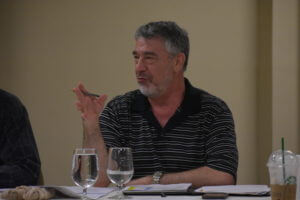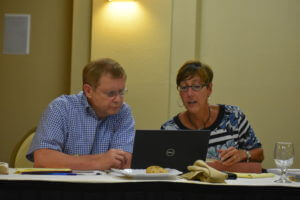
The River Place Limited District considers charging an admission fee for non-residents to hike its popular River Place Nature Trail. Photo by Livitup.com
By LESLEE BASSMAN, Four Points News
River Place Limited District board members discussed the idea to charge admission for those who are not residents but who want to use the popular River Place Nature Trail. That was one of the key topics at the Sept. 25 board meeting where also the entity’s first tax rate was passed and community projects were lined out.
The district was created December 2017, when the city of Austin annexed the River Place neighborhood, making its first fiscal period about nine-and-a-half months — from Dec. 15 until Sept. 30.

River Place Homeowners Association members (from left) President Scott Crosby, Certified Management of Austin employee Peggy Kuhns and Treasurer Ivar Rachkind discuss decreasing member fees for the coming fiscal year during the board’s Sept. 25 meeting. LESLEE BASSMAN
Given a full year of funding, the new tax rate of $0.075 per $100 valuation generates about $28,000 more in revenue than the previous fiscal period, said Michael Luft, bookkeeper for the district’s management company Inframark. The district is now on track to maintain a September-September fiscal year, he said.
Limited District budget
The $510,000 budget for FY 2018-19 — including property taxes, tennis fees, facility rental income, nature trail contributions and interest income — is slated to fund $96,000 for Suntree Park landscaping, utilities and maintenance; $94,000 for Woodlands Park landscaping, utilities and maintenance; $12,000 in nature trail improvements; and just under $9,000 in boardwalk/pond maintenance among other miscellaneous other expenses.
Although the district will end up about $66,000 in the red at the end of the fiscal year, the negative outcome was planned as the entity has an excess of reserves from its years as a municipal utility district, Limited District Treasurer Ivar Rochkind said.

River Place Limited District Treasurer Ivar Rochkind discusses the district’s net deficit budget with the board during its Sept. 25 meeting.
LESLEE BASSMAN
“Having a net deficit budget is by design,” he said of the reserves that will be lowered from $881,000 in FY 2017-18 to $815,000 by the end of FY 2018-19.

River Place Limited District President Scott Crosby discusses the history of the district’s trails and safety committee with residents Sept. 25.
LESLEE BASSMAN
Proposal to charge for trail use by outsiders
Limited District President Scott Crosby led a discussion among board members to possibly include a $15,000 placeholder for a nature trail project that would include staffing trailheads with employees to collect weekend fees from nonmembers of the district before the trail users take to the pathway.
The board elected to not include the funds before approving the district’s budget but would consider amending the budget once the project moves further along.
“Our goal is not necessarily to preclude [trail] use,” said board member Jennifer Mushtaler whoheads up the district’s ad hoc trail and safety committee that is charged with devising long term solutions to keep the trails open and usable for all people. “But as usage continues to increase, how do we balance the needs of residents and Limited District members… with increased usage by those who come to visit?”
A year ago, residents approached the former River Place MUD Board with safety concerns after seeing the increased number of vehicles parked by the lower Big View Drive, or pond, trailhead, Crosby said. At the time, the board was also considering a proposal to have kayak service at the lake, he said.
A proposal to charge for trail usage came before the MUD board at that time but members chose not to vote on the item, instead creating a committee to investigate the safety of the trail and the traffic it brings in from users outside of the neighborhood, Crosby said. A trail reservation system was also discussed but the committee could not come up with the technology to limit trail users, he said. The MUD chose to defer the issue until the Limited District was created, he said.
The current proposal to charge for trail use by nonresidents is only a trial of the system since committee members could not agree as to how much outside trail usage was occurring and peak trail usage times, Mushtaler said. The fees would only be charged during what is believed to be peak trail usage times, on Saturdays and Sundays, she said.
If Inframark managed the staffing company employees needed to man the trail pay stations, Inframark Account Manager Patricia Rybachek said the cost would be about $21-$22 per employee per hour, with three to four employees needed per shift.
“We are in the exploration phase [of the pay station trail project],” Mushtaler said, adding that committee members have looked at other parks and amenities in the state and city of Austin including Emma Long Park off City Park Drive, Barton Springs and Deep Eddy.

River Place Limited District Attorney Philip Haig discusses the FY 2018-19 budget with paralegal Suzanne McCalla.
LESLEE BASSMAN
HOA vs Limited District issue
However, adding to the trail issues is the demarcation between the geographical region of the River Place HOA, which includes the entire neighborhood, and the Limited District, which includes only the areas south of Merrywing Circle. The houses on the west side of River Place Boulevard on Merrywing are part of the Limited District while those on the east side, The Preserve, are not in the Limited District, Crosby said.
When the city of Austin annexed River Place, the area south of Merrywing converted from the former MUD into the Limited District.
Charles Reynolds and Paul Spring, who live north of Merrywing and are not part of the Limited District, voiced their concerns about being among the River Place residents who will be required to pay a fee to use the nature trail situated in their backyard.
“It was not the Limited District’s choice to leave any residents out of the Limited District,” Mushtaler said. “It was where the lines were drawn. When the district was a [MUD] that provided utility service, that was the area [south of Merrywing] that was serviced by the MUD. Those folks that are close to [RM] 2222, they were not receiving utility service from the [MUD but were always serviced by the city of Austin]. It does present a problem for the neighborhood. If the HOA and the neighborhood had its way, it would be much more cohesive.”
Mushtaler, who also sits on the HOA board, said the residents in the two entities — the HOA and the Limited District — are treated differently.
“The annual assessment from the HOA last year was $270 in sum total [per household],” Mushtaler said. “The residents in the Limited District pay seven-and-a-half cents per $100 valuation on their property. It’s a significant difference between what people are paying.”
She said the HOA is “a citizen body” and the Limited District is “a government body” required to adhere to certain state guidelines.
“They are different bodies and they have different boundaries,” Mushtaler said of the HOA and the Limited District.
She said the two entities have different roles, with the HOA managing the community’s codes, covenants and restrictions as well as the neighborhood upkeep and appearance. The Limited District manages the parks/trails and solid waste disposal.
“Overall, we’re trying to keep those groups aligned with the ultimate goal of wanting to preserve the amenities and the quality of the amenities and what we have here as a neighborhood,” Mushtaler said.
The trail payment program is “probably a ways out,” with possibly a spring deadline, she said. “There’s still a lot to work out,” Mushtaler said.
HOA lowers membership fees, seeks board member
Prior to the Limited District meeting, the HOA approved lowering its annual fees from $270 annually per household to $260 annually per household, an action that will give the association a break-even budget for the upcoming year, Rachkind said.
“We have substantial reserves right now,” he said.
The HOA is also seeking another board member following the announcement by BrendaLangford as to her resignation.

